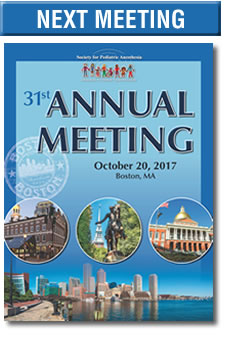spa-aap reviews
Friday Session V - Shaking Up the Status Quo
Reviewed by Zulfiqar Ahmed, MD, FAAP
Anesthesia Associates of Ann Arbor
The first lecture of this session was titled “Challenging Inhaled Anesthesia: TIVA in pediatric anesthesia” and the speaker was Mark Ansermino MBBCh MM. The theme of his talk was to challenge the routine use of inhaled anesthesia and his learning objectives included:
- Reviewing the advantages and disadvantages of total intravenous anesthesia (TIVA) in children.
- Learning the practical differences between the use of TIVA and inhaled anesthesia.
- Discussing adjuvant drugs for the optimal use of TIVA in children.
Dr. Ansermino almost exclusively uses TIVA in his practice, propofol and remifentanil in particular. He started his talk with some basic facts about these two medications. According to their manufacturers, Propofol is:
- Indicated for pediatric anesthesia in children three years of age and older.
- In the absence of sufficient clinical experience, it is not recommended for anesthesia in children less than three years of age.
Due to insufficient safety and efficacy data, Remifentanil is:
-
Not recommended for use in spontaneous ventilation anesthesia, in monitored anesthesia care, for continuation as an analgesic in the immediate postoperative period, in neurosurgery, in cardiac surgery, or in pediatric anaesthesia.
A review article in Pediatric Anesthesia (Lauder GR, 2015) has described the advantages of TIVA techniques including:
- Reduced PONV
- Reduced airway reactivity
- Reduced laryngospasm and bronchospasm
- Bronchodilation
- Prevention of hypoxic pulmonary vasoconstriction
- Neuro-protection
- Decreased intraocular pressure
- Reduced stress hormones
- Reduced pain
According to Dr. Ansermino, TIVA is the anesthetic of choice for core myopathies, malignant hyperthermia susceptible patients, neuromuscular diseases (prevent hyperreflexia and rhabdomyolysis), neurosurgical procedures, scoliosis surgery with SSEP and MEP monitoring, middle ear surgery, patients with a history of severe postoperative nausea and vomiting PONV, laryngotracheal bronchoscopy, maintenance of spontaneous ventilation for out of OR procedures, and patients with known myocardial repolarization abnormalities.
TIVA has the distinct advantage of decreasing emergence delirium. A meta-analysis comparing emergence and recovery profile of five separate anesthetic agents favored propofol. By avoiding volatile agent and N2O contamination, it is an environmentally friendly technique. Due to its favorable context sensitive half-life, patients wake quickly no matter the infusion duration.
Dr. Ansermino shared his preferred anesthetic technique for airway surgery:
- Propofol infusion to keep EEG index < 45 (40 at start)
- Remifentanil to keep RR < 15
- Dexmedetomidine 0.5-1 ug/kg
- Good topical analgesia
Dr. Ansermino described target controlled infusions where EEG sensors convey information to an EEG monitor which then titrates Propofol and Remifentanil infusion rates in a closed loop fashion. The anesthesiologist is able to manually override the pumps if required.
Addressing trainees, Dr. Ansermino recommended:
- Practice TIVA when you do not have to
- Understand context sensitive half time
- Employ a rigorous technique – observe the patient closely
- Embrace processed EEG monitoring
- Use opioids/alpha 2 agonists to reduce Propofol dose
- Blame the surgeon when the patient moves
The next presentation was titled “Gunfight at the OK Corral: NPO guidelines pro-con debate” and the learning objectives were:
- Describe early animal experiments that defined aspiration injury
- Review the large demographic studies that relate to aspiration and NPO time in children and adults
- Describe what might be considered irrational aspects of adherence to NPO guidelines from the ASA
- Review the physiology of gastric emptying
- Describe the plethora of studies leading to the original ASA NPO guidelines
- Discuss outcomes following adherence to the ASA guidelines in children
The first speaker, Ann G. Bailey, MD (University of North Carolina) sought to answer her own question, “Why I think the ASA NPO guidelines are a good thing.”
Starting with historical context, Dr. Bailey mentioned that NPO guidelines emerged in 1847. Until that time textbooks had no guidelines for eating before surgery and only mentioned emesis to be an unpleasant experience. In 1883, Sir John Lister published fasting guidelines of two hours for clears (tea or beef tea) and no solids before surgery. The first aspiration report was published in 1848. ASA published its guidelines in 1999 with the purpose of providing “direction for clinical practice related to preoperative fasting”.
Supporting literature for NPO guidelines includes work by Splinter et al (Can J Anaesth 1989; 36:55) showing the effect of apple juice on gastric contents, thirst, and hunger in children. In this study, patients were NPO after midnight and the intervention group received 3 ml/kg of apple juice 2.5 hours before surgery. Lower gastric fluid volume were found in patients who had apple juice (0.24 vs 0.43 ml/kg). Patients who received apple juice were also less hungry and thirsty than the control group. During the 1990’s a plethora of studies were published on the subject of NPO status. One study by Schreiner et al (Anesthesiology 1990; 72:593) compared patients who were either NPO past midnight or received clear liquids two hours before surgery. The data showed no difference in gastric volumes or pH between the two groups.
Gastric emptying develops a mature pattern by 32 weeks gestation. Emptying times of 8-18 minutes for inert liquids such as water or saline follow first order kinetics. One study demonstrated adequately low gastric fluid volume in children 120 minutes after 7 ml/kg raspberry drink (Br J Anaesth 2011; 107:425). Pea and whey proteins have faster gastric emptying time than milk protein and are intermediate value between glucose and milk protein (J physiology 1997; 498:553). Adding amino acids to glucose solution has been demonstrated to lower gastric fluid volume (NutrHosp 2011; 26:86).
The effect of breast milk on gastric fluid volume (GFV) was also discussed. A study by Litman et al showed that 7/24 patients had GFV more than 1 ml/kg compared to 3/46 patients on clear liquids (0.4 ml/kg) two hours before surgery (Anesth Analg 1994; 79:4820). With increasing caloric density, gastric emptying of oral fluids slows proportionally.
The incidence of aspiration in anesthetized children is reported to be between 2-25/10,000. Dr. Bailey’s final thought was the role of carbohydrate loading for ERAS protocols and the effect on perioperative insulin activity. She presented a study in which the treatment group received 10 ml/kg 12.6% carbohydrate solution the night before surgery and again two hours preoperatively as compared to the control group. Insulin resistance was significantly higher in the control group. Also, an increase in postoperative insulin resistance was seen in the control group (Anaesthesiol Intensive Ther 2014; 46:61).
The second debate speaker, Joseph Cravero, MD (Boston Children’s Hospital), philosophized that everything we know to be true today may change in the future. As an example, he challenged the assumption that “a certain volume” of gastric aspirate is needed to cause injury. He also asked if we really know “what volume” is left in the stomach after intervals of fasting. ASA guidelines suggest that 0.4 cc/kg stomach contents risks aspiration but this is based on preliminary work from Rhesus monkeys with no confirmatory data.
In one study, the incidence of aspiration in emergency cases was 1:373 and all children who aspirated had significant systemic illness such as bowel obstruction or bowel ischemia (Warner et al 1999). Dr Cravero argued that NPO guidelines are not written in stone and are not based on sound evidence. Furthermore, Emergency Medicine literature has failed to demonstrate a connection between aspiration and NPO guidelines, leading that specialty to publish their own NPO guidelines.
Many factors exist to explain why aspiration syndrome is a rare phenomenon. A critical amount of gastric content is needed. Active and/or passive regurgitation must occur. The regurgitated fluid must be aspirated and finally the aspiration must cause injury.
Randomized controlled trials (RCTs) have shown that fasting intervals between two to four hours for fluids result in less thirst and hunger. RCTs have also shown lower gastric fluid volumes and higher pH when clear liquids are administered. Consultants and ASA agree that a two-hour clear fluid interval for infants, children and adults should remain for anesthesia or procedural sedation. Consultants and ASA strongly agree that a light meal should wait six hours and fatty foods eight hours prior to anesthesia or procedural sedation.
Guidelines may not apply to or may require modification for patients with coexisting diseases or conditions that affect gastric emptying or fluid volume. NPO guidelines are often simplified and may lead to extended NPO periods for children. That results in fluid deficits, hypoglycemia and endocrine changes in the bowel.
In conclusion, our obsession with gastric fluid volume persists because it is logical yet there is no data to correlate this with rates of aspiration injury. We tend to practice as though NPO guidelines are written in stone and based on great evidence. We consider NPO status to be a binary phenomenon i.e. a patient is NPO or not NPO, which really is an illogical approach to this process.






